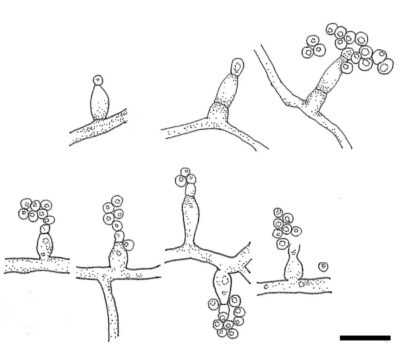Fungalpedia – Note 362, Psychrophila
Psychrophila Psychrophila M.M. Wang & Xing Z. Liu
Citation when using this data: Tibpromma et al. 2024 (in prep.) – Fungalpedia, extreme-tolerant fungi.
Index Fungorum, Facesoffungi, MycoBank, GenBank, Fig. 1
Classification: Incertae sedis, Helotiales, Leotiomycetidae, Leotiomycetes, Pezizomycotina, Ascomycota, Fungi.
Psychrophila was established with the type species Psychrophila antarctica, and its generic name is a cold-loving fungi group that is well adapted to low-temperature habitats (Wang et al. 2015). To date, Psychrophila accepted another three species (P. lagodekhiensis, P. lutea, and P. olivacea) and these species were found in preservative-treated wood and soil, rhizosphere of Hedera helix in China, Georgia and Sweden; also, from soil in Great Wall Station of Antarctic (Untereiner et al. 2019). Psychrophila has been morphologically described by having phialides, collarettes, vegetative hyphae, conidiophores that are reduced to conidiogenous cells, sometimes short, or much differentiated; wedge-shaped to campanulate and widely flaring collarettes, forming hyaline, pyriform to globose conidia (Wang et al. 2015). Meanwhile, four genes (LSU, ITS, TEF1, and TUB) were applied to carry out phylogenetic analysis and phylogenetic position of Psychrophila relatively close to Hymenoscyphus (Helotiaceae) (Wang et al. 2015).
Type species: Psychrophila antarctica M.M. Wang & Xing Z. Liu
Other accepted species: Species Fungorum – search Psychrophila
Figure 1 – Morphology of Psychrophila . Phialides with conidia. Scale bar = 10 μm. Redrawn from Untereiner et al. (2019).
References
Entry by
Yang EF, Department of Biology, Faculty of Science, Chiang Mai University, Chiang Mai 50200, Thailand; Center for Yunnan Plateau Biological Resources Protection and Utilization, College of Biological Resource and Food Engineering, Qujing Normal University, Qujing, Yunnan 655011, China.
(Edited by Saowaluck Tibpromma, Samaneh Chaharmiri-Dokhaharani, & Achala R. Rathnayaka)
Published online 14 November 2024
